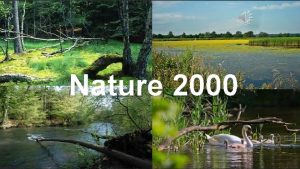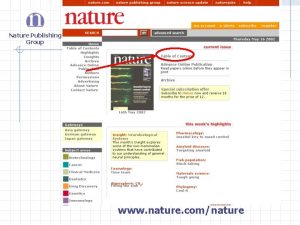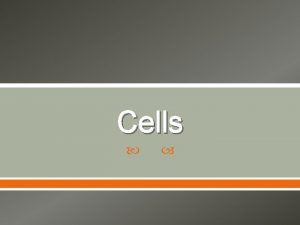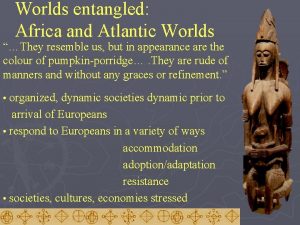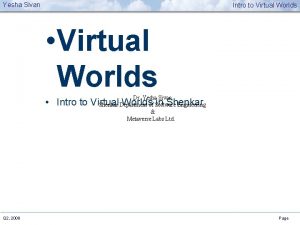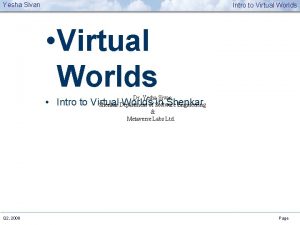3 SMALL WORLDS The WattsStrogatz model WattsStrogatz Nature





























![3 rd moment is high [clustering, large number of triangles] 3 rd moment is high [clustering, large number of triangles]](https://slidetodoc.com/presentation_image_h2/7860ddab1f630754f412da68f72f7a25/image-30.jpg)
- Slides: 30

3. SMALL WORLDS The Watts-Strogatz model

Watts-Strogatz, Nature 1998 Small world: the average shortest path length in a real network is small Six degrees of separation (Milgram, 1967) Local neighborhood + long-range friends A random graph is a small world

Networks in nature (empirical observations)

Model proposed Crossover from regular lattices to random graphs Tunable Small world network with (simultaneously): – Small average shortest path – Large clustering coefficient (not obeyed by RG)

Two ways of constructing

Original model Each node has K>=4 nearest neighbors (local) Probability p of rewiring to randomly chosen nodes p small: regular lattice p large: classical random graph

p=0 Ordered lattice

p=1 Random graph

Small shortest path means small clustering? Large shortest path means large clustering? They discovered: there exists a broad region: – Fast decrease of mean distance – Constant clustering


Average shortest path Rapid drop of l, due to the appearance of short-cuts between nodes l starts to decrease when p>=2/NK (existence of one short cut)

The value of p at which we should expect the transtion depends on N There will exist a crossover value of the system size:

Scaling hypothesis

N*=N*(p)


Crossover length d: dimension of the original regular lattice for the 1 -d ring

Crossover length on p

General scaling form Depends on 3 variables, entirely determined by a single scalar function. Not an easy task

Mean-field results Newman-Moore-Watts

Smallest-world network


L nodes connected by L links of unit length Central node with short-cuts with probability p, of length ½ p=0 l=L/4 p=1 l=1

Distribution of shortest paths Can be computed exactly In the limit L-> , p->0, but =p. L constant. z=l/L

different values of p. L

Average shortest path length

Clustering coefficient How C depends on p? New definition C’(p)= 3 xnumber of triangles / number of connected triples C’(p) computed analytically for the original model

Degree distribution p=0 delta-function p>0 broadens the distribution Edges left in place with probability (1 -p) Edges rewired towards i with probability 1/N notes

only one edge is rewired exponential decay, all nodes have similar number of links

Spectrum ( ) depends on K p=0 regular lattice ( ) has singularities p grows singularities broaden p->1 semicircle law
![3 rd moment is high clustering large number of triangles 3 rd moment is high [clustering, large number of triangles]](https://slidetodoc.com/presentation_image_h2/7860ddab1f630754f412da68f72f7a25/image-30.jpg)
3 rd moment is high [clustering, large number of triangles]
 Norton worlds together worlds apart
Norton worlds together worlds apart Nature and nature's law lay hid in night
Nature and nature's law lay hid in night Determinace lidské psychiky
Determinace lidské psychiky Hình ảnh bộ gõ cơ thể búng tay
Hình ảnh bộ gõ cơ thể búng tay Lp html
Lp html Bổ thể
Bổ thể Tỉ lệ cơ thể trẻ em
Tỉ lệ cơ thể trẻ em Voi kéo gỗ như thế nào
Voi kéo gỗ như thế nào Tư thế worm breton là gì
Tư thế worm breton là gì Hát lên người ơi
Hát lên người ơi Các môn thể thao bắt đầu bằng tiếng nhảy
Các môn thể thao bắt đầu bằng tiếng nhảy Thế nào là hệ số cao nhất
Thế nào là hệ số cao nhất Các châu lục và đại dương trên thế giới
Các châu lục và đại dương trên thế giới Công thức tính thế năng
Công thức tính thế năng Trời xanh đây là của chúng ta thể thơ
Trời xanh đây là của chúng ta thể thơ Cách giải mật thư tọa độ
Cách giải mật thư tọa độ 101012 bằng
101012 bằng độ dài liên kết
độ dài liên kết Các châu lục và đại dương trên thế giới
Các châu lục và đại dương trên thế giới Thơ thất ngôn tứ tuyệt đường luật
Thơ thất ngôn tứ tuyệt đường luật Quá trình desamine hóa có thể tạo ra
Quá trình desamine hóa có thể tạo ra Một số thể thơ truyền thống
Một số thể thơ truyền thống Cái miệng bé xinh thế chỉ nói điều hay thôi
Cái miệng bé xinh thế chỉ nói điều hay thôi Vẽ hình chiếu vuông góc của vật thể sau
Vẽ hình chiếu vuông góc của vật thể sau Biện pháp chống mỏi cơ
Biện pháp chống mỏi cơ đặc điểm cơ thể của người tối cổ
đặc điểm cơ thể của người tối cổ Thế nào là giọng cùng tên
Thế nào là giọng cùng tên Vẽ hình chiếu đứng bằng cạnh của vật thể
Vẽ hình chiếu đứng bằng cạnh của vật thể Tia chieu sa te
Tia chieu sa te Thẻ vin
Thẻ vin đại từ thay thế
đại từ thay thế


































